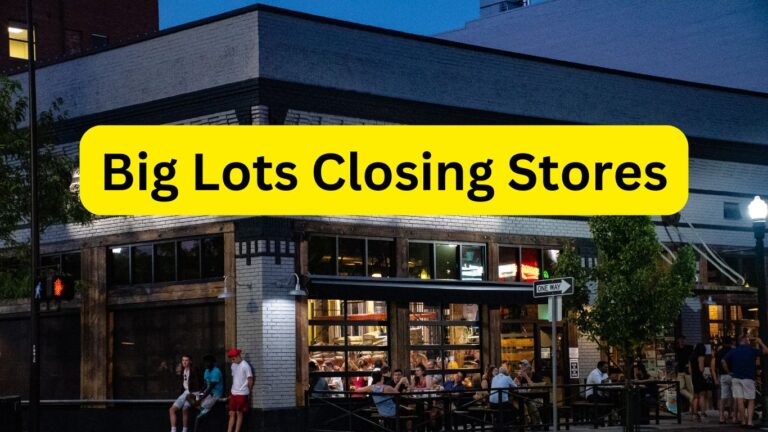Big lots closing stores – Big Lots has long been a go-to destination for bargain hunters across the nation. Known for its wide selection of furniture, home goods, and groceries at discounted prices, this retailer carved out a unique space in the hearts of shoppers. But recent news about big lots closing stores has left many wondering what’s next for their beloved local locations. As changes unfold in the retail landscape, customers are curious about how these closures will affect them and what alternatives they might have. Let’s dive into the reasons behind these decisions and explore what Big Lots plans to do moving forward.
Reasons for Big Lots Closing Store
The recent news of Big Lots closing stores has sparked conversations across the retail landscape. Several factors contribute to this decision. Shifting consumer behavior plays a significant role. Many shoppers are opting for online purchases rather than in-store visits. This trend puts pressure on brick-and-mortar locations.
Additionally, economic challenges have impacted sales figures. Rising operational costs and inflation can squeeze profits, making it difficult to sustain certain locations. Furthermore, competition from other retailers intensifies the struggle for market share. New discount chains and e-commerce giants continue to lure customers away with attractive options and pricing strategies. Underperforming sites may no longer align with Big Lots’ overall business strategy. The company is likely refocusing its efforts on more profitable areas while adapting to an ever-changing marketplace.
Impact on Employees and Customers
The decision to close Big Lots stores brings a wave of uncertainty. Employees face job loss, leaving many wondering about their future. For those who have built careers within the company, this is particularly disheartening. Customers also feel the impact deeply. Loyal shoppers will miss their favorite aisles filled with discounted goods and unique finds. The sense of community fostered in these local stores cannot be easily replaced.
Some customers may need to travel further for similar shopping experiences, which could disrupt their routines. Additionally, small towns that rely on Big Lots for affordable household items might suffer economically. Support systems are crucial during this transition period for everyone involved. Open communication from management can help ease concerns among employees while offering some guidance to loyal patrons searching for alternatives.
How Big Lots Plans to Move Forward
Big Lots is adapting to the evolving retail landscape. The company acknowledges the challenges posed by increased competition and changing consumer behaviors. To navigate these shifts, Big Lots is focusing on enhancing its e-commerce capabilities. Investments in their online platform aim to provide a seamless shopping experience for customers who prefer convenience.
Additionally, they are revamping store layouts to create inviting environments that encourage shoppers to explore more products. This strategy includes introducing new merchandise categories that resonate with current trends and customer demands. Community engagement remains vital too. Big Lots plans initiatives aimed at strengthening local ties through partnerships and events, ensuring they remain relevant in each market they serve.
By prioritizing innovation and community connection, Big Lots seeks not only to survive but thrive in an ever-competitive sector.
Alternatives for Customers
As Big Lots closes stores, customers might feel uncertain about where to shop next. Thankfully, there are several alternatives to consider. Dollar Tree and Dollar General offer similar discount shopping experiences. They provide a range of household goods, snacks, and seasonal items at budget-friendly prices. For those looking for furniture or home decor, check out stores like Big R or Ollie’s Bargain Outlet. These retailers often feature unique finds that won’t break the bank.
Online options also abound. Websites such as Wayfair and Overstock have extensive selections with competitive pricing. Don’t forget local thrift shops! They can be treasure troves filled with unique items at low costs while supporting your community. Exploring these alternatives means you can keep enjoying great deals even amidst store closures.
What this Means for the Retail Industry
The news of Big Lots closing stores sends ripples through the retail industry. It highlights a shift in consumer behavior and preferences that many retailers can no longer ignore. As customers lean toward online shopping, brick-and-mortar stores face immense pressure to adapt. The closures may be a wake-up call for other chains struggling with foot traffic.
Retailers might need to rethink their strategies, focusing more on e-commerce capabilities while also enhancing the in-store experience. Collaboration with tech companies could become essential to attract shoppers back into physical locations. Investors will likely keep a close eye on how these changes unfold across various sectors. This situation sets the stage for innovation and transformation within retail, prompting businesses to pivot or risk falling behind amidst evolving market dynamics.
Remarks
Big Lots has been a staple in the retail landscape, known for its variety of products at affordable prices. However, the recent announcement about big lots closing stores has sparked concern among customers and employees alike. The reasons behind these closures are multifaceted, ranging from financial struggles to changing shopping behaviors. As we delve deeper into this situation, it’s crucial to understand how it impacts not only those who work there but also loyal customers who relied on Big Lots for their shopping needs. Employees face uncertainty regarding their jobs, while shoppers may need to rethink where they find bargains on everyday essentials. Looking ahead, Big Lots is formulating strategies to navigate through these challenging times. They aim to enhance online offerings and optimize existing locations that remain open. This shift reflects broader trends in retail as companies adapt to meet changing consumer preferences. For those affected by store closings, alternative options are emerging. Other discount retailers and online marketplaces can provide similar value propositions. It’s essential for consumers to explore new avenues without losing sight of affordability.
The ripple effects of big lots closing stores extend beyond individual locations; they highlight ongoing shifts within the retail industry itself. As businesses reassess their strategies amidst economic pressures and evolving customer habits, many will be watching closely how Big Lots adjusts its approach moving forward.
This chapter marks a significant transition for both Big Lots and its community members involved directly or indirectly with the brand’s future trajectory.

